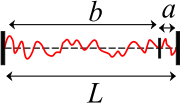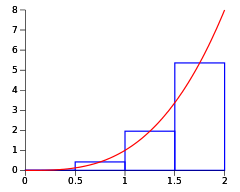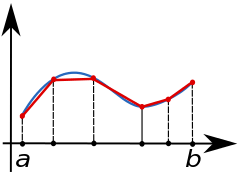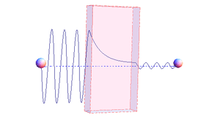Quantum mechanics/Casimir effect in one dimension
< Quantum mechanicsThis Youtube video[1] piqued my interest because a highly educated speaker is claiming that the sum of all positive integers equals -1/12. He "proves" it using dubious math, but also showed an excerpt from a textbook on string theory that contained the equation Σ n = -1/12. He also asserts that we have experimental evidence that this equation is true. This discussion of the Casimir effect casts a more realistic light[2] on the value of Σ n = -1/12.
How much electromagnetic energy is stored in an empty conducting box at (absolute) zero temperature?
A simple quantum field theory yields this expression for the energy of almost any linear wave:[3]
 ,
,
 corresponds to the "number of photons" associated with a given normal mode. At a sufficiently low temperature, we may take
corresponds to the "number of photons" associated with a given normal mode. At a sufficiently low temperature, we may take  as a reasonable approximation and focus entirely on the ground state energy. For simplicity, we shall also adopt units where
as a reasonable approximation and focus entirely on the ground state energy. For simplicity, we shall also adopt units where  . Hence, energy, E, wavenumber, k = 2π/λ, and angular frequency, ω, all have the same units. Taking two polarizations for each normal mode of standing waves in a box with spatial dimensions
. Hence, energy, E, wavenumber, k = 2π/λ, and angular frequency, ω, all have the same units. Taking two polarizations for each normal mode of standing waves in a box with spatial dimensions  , the three-dimensional sum over all possible wavenumbers yields,
, the three-dimensional sum over all possible wavenumbers yields,
To keep the mathematics simple, we consider the artificial one-dimensional "box" of length  , and instead, consider this sum:
, and instead, consider this sum:
Exponential regularization
Our first task is to regularize this divergent series by replacing it with something more manageable. Each integer represents a successively larger wavenumber. It is reasonable to assume that this summation ceases to be valid above some threshold energy. For example, metal ceases to be a good conductor at high frequency due to the skin effect. In cosmology, the energy/mass equivalence seems to imply an infinite source of gravity. Exponential regularization is one of many ways to model this cuttoff above some threshold frequency. Loosely speaking, Σn=Σne−α in the limit that α vanishes, but the regularized sum in not an analytic function of α at α = 0.
where the last step defined u=e−α and used the well-known result for  ,
,
Using the quotient rule to evaluate the derivative, we obtain[4]:
Consider the following Taylor expansion around α = 0:
Use this approximation to take the square of the inverse:
optional:using MATLAB to calculate the higher order terms
Interpretation
Loosely speaking, the wave energy, E, and length of our one dimensional box, a, are related by[6],
We shall soon see that the infinity is exactly cancelled out by the ground-state energy density that exists outside the two plates, in a region of space we shall call the "universe". Then we shall argue that regularization is not a mysterious mathematical trick, but a physically realistic model that represents the fact that metal is not a good conductor at sufficiently high frequency. Moreover, no harm was done by assuming exponential regulation, since any sufficiently smooth high-frequency cutoff yields the same result.
In order to assign a physical meaning to  , define a critical mode number
, define a critical mode number  associated with the high energy/frequency cutoff:
associated with the high energy/frequency cutoff:
The contribution of each mode to total energy begins to fall by a factor of e at this wavenumber:
from which we conclude that  . The total energy in our one-dimensional box is:
. The total energy in our one-dimensional box is:

The Casimir force is caused by the change in total energy when the length, a, changes. Let our universe consist of a very large box of length, L, as shown in the figure. Ground state photon modes exist in two boxes, one of length, a, and the other of length b = L − a. The total energy is U = Ea+Eb

The large term plays no role in calculating the force because it is constant (since a + b = L). The small term may be neglected because b >> a. Also, it should be noted that the force, F = −∂U/∂x is larger in this artificial one-dimensional model than it would be for actual parallel plates in three dimensions.
The Casimir effect holds for any sufficiently gentle regularization function
The choice of an exponential regularization function might seem arbitrary to some readers. Here we show that the same result is obtained for any sufficiently gentle regularization of the infinite series, 1+2+3+4+....



The first step is to convince yourself that,
 ,
,
where we have subdivided the integral as a Riemann sum with intervals of length h.
Where N is the number of points in the interval of integration, from  to
to  . Here,
. Here,  initially, so that
initially, so that  . Then above some arbitrary large mode number,
. Then above some arbitrary large mode number,  must gradually level off and approach a situation where
must gradually level off and approach a situation where  . In this equation, the integral (LHS[7]) represents the continuum of states in the "universe" (outside the plates), and the sum (RHS) represents the spectrum of standing waves between the plates. The first, correction term,
. In this equation, the integral (LHS[7]) represents the continuum of states in the "universe" (outside the plates), and the sum (RHS) represents the spectrum of standing waves between the plates. The first, correction term, ![\frac{h^2}{12}[f'_0 - f'_N]](../I/m/8f629724c9cddcc0474bbfcb6c8e2d83.png) , represents the fact that in a regularized version of the theory, the sum must be slightly smaller than the integral. This line of reasoning suggests that it is the concave down nature of the regularization that explains why the plates are attracted.
, represents the fact that in a regularized version of the theory, the sum must be slightly smaller than the integral. This line of reasoning suggests that it is the concave down nature of the regularization that explains why the plates are attracted.
Unsolved mystery? The question of why adopting the asymmetric boundary conditions[8] causes the plates to attract must remain as an unsolved mystery.
Regularization is not an artificial "trick"

The quantum field theory used to develop this model is based on the classical wave equation. This classical wave equation can also be used to model finite resistivity of the wave equation, and can also be quantized, provided the wave equation is not dissipative. (Quantum theories are largely incompatible with friction or any other dissipative effect.) All that is necessary to achieve second quantization is to express the wave Hamiltonian in terms of eigenstates of the classical wave equation.
To better model the Casimir effect, one might assume that an inductive impedance dominates at high frequencies. It seems to me'[9] that this would cause the low frequency eigenstates to be segregated by the plates, but cause the high frequency eigenstates to occupy both sides of the plate. This would gradually reduce the difference in energy density between the two spatial regions, causing a careful calculation to yield a regularized version of the infinite series 1+2+3+4+.... The previous section showed that the result does not depend on the nature of this regularization, provided the transition from confined (e.g. radio waves) to unconfined waves (e.g. X-rays) is sufficiently gradual.
It does not seem that exponential regularization of the series, 1+2+3+4+..., is an artificial trick. In fact, it informs us that the mechanism that causes the Casimir effect is that at sufficiently high frequencies, the ground-state electromagnetic energy levels are not restricted to the region between the plates. This creates a frequency range in which the waves begin to "leak" or "tunnel" between two locations (i.e. between the plates and outside them). Regularization informs us that if we know the high-frequency cut-off for confinement of standing waves by the plates, then we will know what frequencies are largely responsible for the Casimir effect. This transition regime consists of frequencies for which the penetration through the metal plates is considerable but not so large that the plates are essentially transparent.
This is one of four Wikiversity resources on divergent series
- Divergent_series
- Quantum mechanics/Casimir effect in one dimension
- Quantum mechanics/Quantum field theory on a violin string.
- MATLAB/Divergent_series_investigations
Other references
- ↑ the video had 2.5 million hits as of November 2014
- ↑ pun intended
- ↑ The only requirement is that the wave energy be proportional to the square of the wave amplitude integrated over all space. Also, for simplicity I assumed a scalar wave, although the same expression also holds for an EM wave.
- ↑ Bordag, Michael, Umar Mohideen, and Vladimir M. Mostepanenko. "New developments in the Casimir effect." Physics reports 353.1 (2001): 1-205 (see Equation 2.12 on page 12) http://arxiv.org/abs/quant-ph/0106045 and http://cecelia.physics.indiana.edu/journal/casimir_review.pdf See the same equation as Eq. 2.14 on page 19 of http://books.google.com/books?id=CqE1f_s5PgYC&pg=PA33#v=onepage&q&f=false
- ↑ http://mathworld.wolfram.com/BernoulliNumber.html
- ↑ Here we have reinserted the factor ħc convert the energy to conventional units.
- ↑ Left-hand side
- ↑ It seems to me that regularization always a produces concave down summation of confined normal modes. But see: Boyer, Timothy H. "Casimir forces and boundary conditions in one dimension: Attraction, repulsion, Planck spectrum, and entropy." American Journal of Physics 71.10 (2003): 990-998. http://arxiv.org/pdf/quant-ph/0211109v1.pdf
- ↑ I can't find the Wikiversity template that requests verification of an unsourced claim.














![E = \frac\pi a \left[\frac{1}{\alpha^2}-\frac{1}{12} \right]=\frac{a\kappa_c^2}{\pi}-\frac{\pi}{12a}](../I/m/78b683e3a9a61e18fd9f9e89cc3c5548.png)
 .
. ![\int_a^b f(x)\,dx =h\left(\frac{f_{0}}{2} + f_1 +f_2...+f_{N-1} + \frac{f_{N}}{2}\right) + \left[\begin{matrix} \mathrm{correction} \\ \mathrm{term}\end{matrix} \right]](../I/m/4af04b7ad58dfad707a0fd95bdbe4e0f.png)


 .
.![\int_{x_{k-1}}^{ x_{k+1}}\left[ f_k + (x-x_k)f_k' + \frac 1 2 \right(x-x_k\left)^2f_k''\right]\,dx](../I/m/6f62f0ecf1477ddcd000b24051a4acc3.png)
